Results of survey carried out by Caucasus Times in North OssetiaAn overwhelming majority of inhabitants of North Ossetia see the relations with the adjacent Ingushetia and unresolved South Ossetian question as the most acute problem.
(Caucasus Times) - On July 10-15 2005, Caucasus Times has carried out a quick survey of 200 inhabitants (98 men and 102 women) of Vladikavkaz, the capital of North Ossetia. Results of the survey indicate an extremely high degree of concern among the local population regarding the state of affairs in the bordering regions (South Ossetia and Ingushetia), a high degree of dissatisfaction with the investigation of the terrorist act in Beslan, and an extremely pessimistic mood with respect to the consequences of the leadership change in North Ossetia.
MOST ACUTE PROBLEMS OF NORTH OSSETIA
57 % of those interviewed consider relations with Ingushetia to be among the most acute problems in North Ossetia, while 21% of respondents see the resolution of the South Ossetian problem as the most urgent issue in the Republic. At the same time, most respondents (84 %) think that security (local crime and terrorism) is the most pressing problem in the region. 38 % find socio-economic problems (unemployment, low wages) to be the most critical.
THE MOST OPTIMAL SOLUTION TO THE PROBLEM OF SOUTH OSSETIA
A wide spectrum of opinions was clearly visible in answers to a question about the optimal solution of the issue of South Ossetia. According to 36% of respondents, the best solution is unification with North Ossetia inside the Russian Federation. A little less, or 33%, recommend to join Russia as a separate republic. Finally, 31% think that the best solution is to retain its status quo as a non-recognized republic. It is important to underline that none of the 200 respondents thought that "joining Georgia" was the best possible solution.
SATISFACTION WITH THE INVESTIGATIVE PROCESS OF THE TERRORIST ACT IN BESLAN
When asked about the level of satisfaction with the investigation of the terrorists act in Beslan, an overwhelming 97% majority expressed their disappointment; 1% demonstrated partial satisfaction; none of the 200 respondents voiced satisfaction; and 2% found it difficult to answer this question.
CHANGE OF LEADERSHIP IN NORTH OSSETIA
The North Ossetian leadership change that took place in the beginning of this June divided the respondents into approximately two equal camps. 36% think the changes in North Ossetia "will rather worsen" the situation, while 32 % think that it "will rather improve" it. 9% assume this "will improve" the situation, while only 8% expect it to get worse. A significant part of those interviewed (15%) could not answer this question.
MAIN SOURCES OF INFORMATION
Television
Television dominates (81%) as the source of daily news in North Ossetia. Most viewers in North Ossetia choose central Russian channels RTR and ORT (46%). NTV comes in second with 27%, while VGRTK "Alaniya" is third with 15%. European "EuroNews" is very popular with 7% of the population watching it. 1% prefer REN-TV.
Press
Among the main sources of information, the press is in second place with 48%. The leaders are the republic-wide newspapers North Ossetia (12%), Ossetia: an Independent Look (7%), Pulse of Ossetia (6%) and Vladikavkaz (1%).
The most popular among all Russian newspapers are Kommersant and Moskovsky Komsomolets, with 5% each. They are closely followed by Argumenty i fakty (4%) and Novaya Gazeta (3%). 1% of respondents read the Vedomosti newspaper.
Radio
Radio is the third in the list of main sources of information with 35%. The most popular radio station in the Republic is "Echo of Moscow", listed as a main source of information by 20% of respondents. Other popular radio stations include the "VGRTK" radio (9%) and the Russian desk of "Radio Liberty" (6%).
Internet
Internet is the fourth, but nonetheless important, source of information with 34%. Among the most visited news sites were "news.yandex.ru" (16%), "15th Region" (12%), website of the Russian desk of "Radio Liberty" (4%) and the website of the daily Kommersant (2%).
LEVEL OF TRUST IN MEDIA
Television is the most trusted source of information (73%). The most trusted station is NTV (32%), followed by RTR and ORT (23%) and VGRTK "Alaniya" (6%). Euronews is trusted by 7% of those who participated in the survey. It is worth mentioning that the same share of respondents trust "Euronews" in neighbouring Dagestan.
A rather large share of respondents (32%) trusts the internet: "News.yandex.ru" with 14% is the most popular among websites, followed by "15th Region" (11%), the Russian desk of "Radio Liberty" (2%) and the website of the daily Kommersant (1%).
36% of respondents have confidence in newspapers. Novaya Gazeta enjoys the trust of 14% respondents. A little less or 13% have confidence in a republic-wide Ossetia: an Independent Look, 9% trust Pulse of Ossetia.
Respondents think that most trustworthy radio stations are "Echo of Moscow" (17%), the Russian desk of "Radio Liberty" (6%) and VGRTK (3%).
For 7% of those interviewed communication with friends and relatives serves as the main source of information.
Note: This survey was carried out within a framework of a twelve-month project "Public opinion in North Caucasus" aimed at monitoring public opinion and implemented in all the republics of Northern Caucasus by the financial support of the US fund NED. Distribution of answers in the survey is given in percentages. A statistical error in such surveys is within a 7% limit. Two answers were allowed for some questions.
Charts (answers are in per cent):
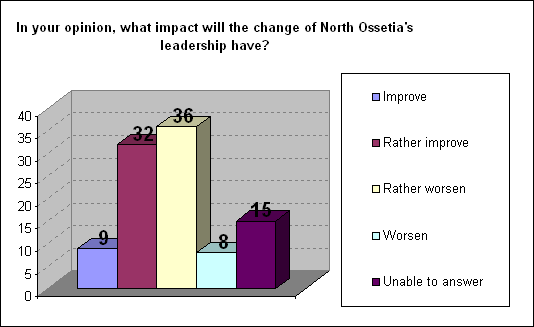
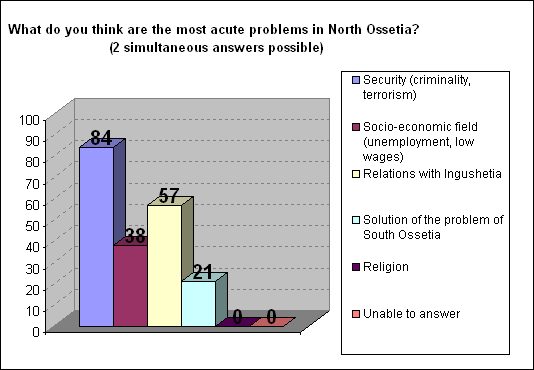
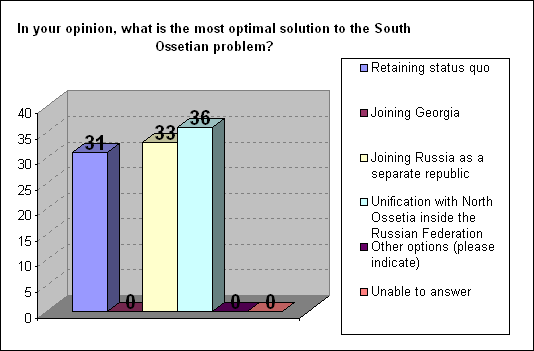
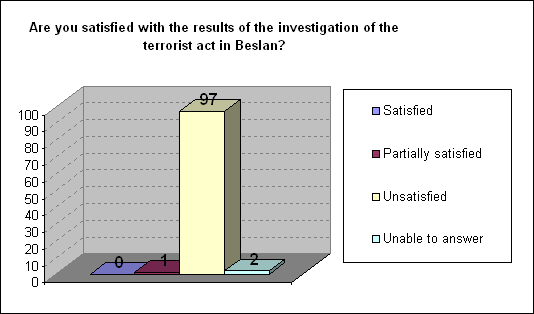
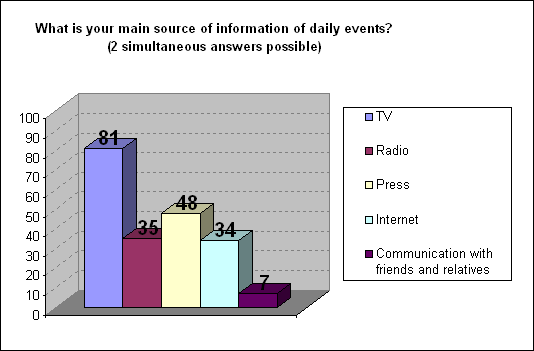
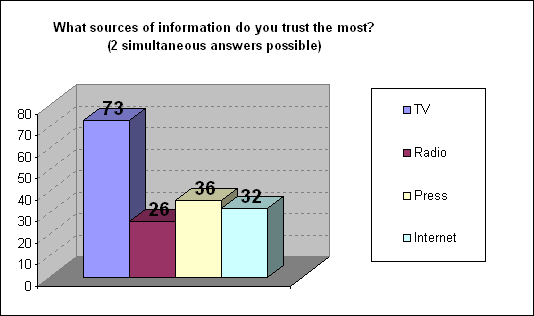
Translated by Mindaugas Kojelis.
(MK/E,T,B)
DISCUSSION FORUM
|

